Dell U2311H: E-IPS, Full Adjustments, and DisplayPort
by Chris Heinonen on September 27, 2011 12:20 AM ESTColor Accuracy
Next up I went to calibrate the monitor using an i1D2 colorimeter from Xrite and a copy of ColorEyes Pro using a MacBook Air as the test platform. Initially I attempted to do the calibration on my Windows 7 machine, but my video card seemed to have an issue with the LUTs and ColorEyes, as the dE performance got worse after the calibration than before. Performance on the Mac seemed to be correct and more in line with what is expected after a calibration.
One downside of ColorEyes is that it doesn’t specify the DeltaE formula used and so it is generally believed to be dE 1976 instead of the more recent dE 1994 or dE 2000 formulas that take into account perceptual factors better. With dE 1976 any value below 1.0 is considered perfect for all practical considerations, while a value below 2.0 is considered good enough for print applications. Values below 3.0 are considered invisible to the naked eye and are really the target for all calibrations.
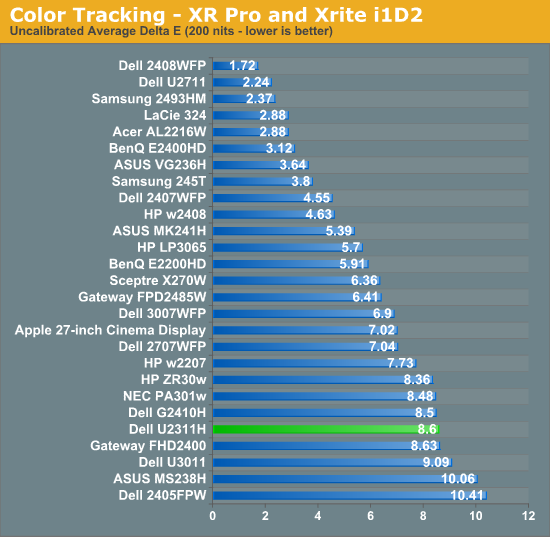
First we looked at the uncalibrated performance with the monitor set to 200 nits and using the include ICM profile from Dell. As you can see, we wind up way off our target dE of 3.0 with an average of 8.6 and a peak value of 14.85. Compared to some other displays this actually isn’t too bad, but it’s nothing you would want to use for serious color work.
For the initial calibration, we used the Custom (RGB) mode on the Dell and calibrated the 100% White Point using the RGB gain controls to be as accurate as possible. We then set calibration targets of 200 nits, D65 for a white point, and a gamma target of 2.2. Once calibrated, we compared the results using the GregTag Macbeth color checker patterns.
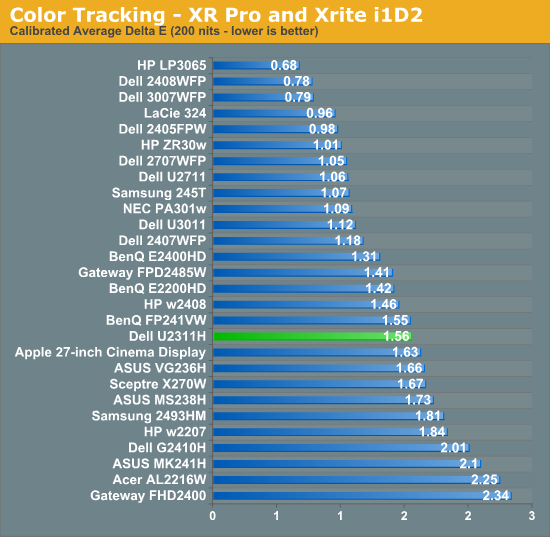
Once we calibrate the Dell, we see our average dE has dropped all the way down to 1.56 and the peak dE is at 5.03. Another thing to keep in mind is that the patches that are generating the highest dE values are ones that are made up mostly of blue. Given your choice, blue is where you want the majority of your dE to occur and green is where you want the least to occur, as the blue light is much lower in light output than red or green, and so errors are not nearly as visible to your eye as they would be in the other colors. Additionally, since the blue light output is much lower, it’s also harder for a colorimeter like the i1D2 to read and therefore more subject to reading errors than green would be. This could account for some of this error and a meter with better dark reading support could resolve that, though most people won’t have one of those for calibrating.
For print work, we then calibrated the monitor using the same specifications, only with a target of 100 nits instead of 200 nits. For a lit room most people would consider this to be too dark of an image, but for print work its much closer to what your actual output would look like.
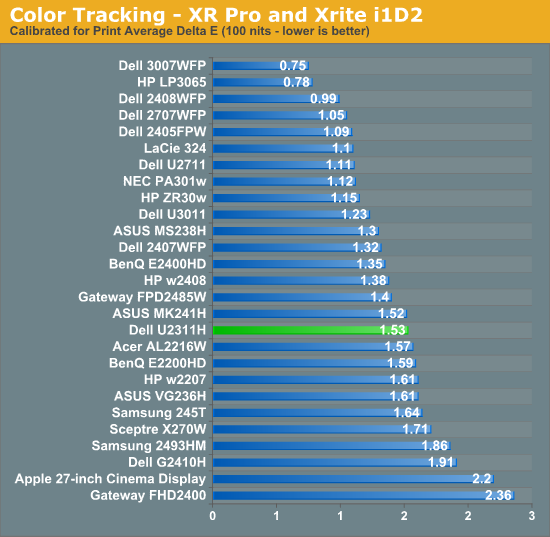
Our average dE here is almost identical at 1.56 but the peak dE is down to 4.75. Again these spikes are occurring in that range that is heavily blue and less noticeable by the human eye. There is a good chance that for the majority of your work you will not have a color error that is visible to the naked eye.


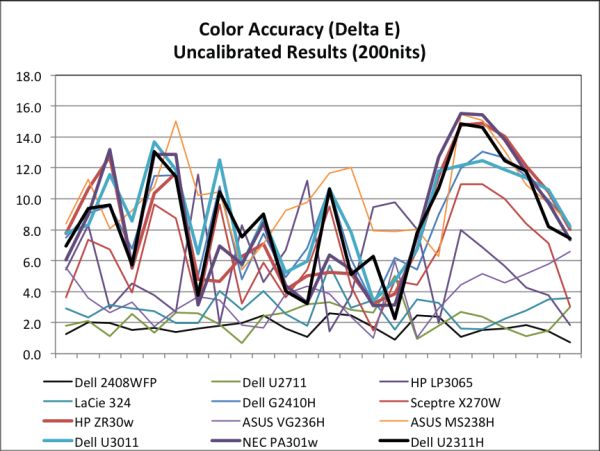
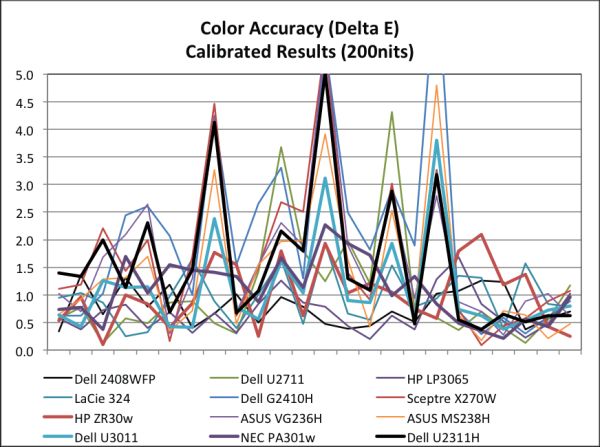
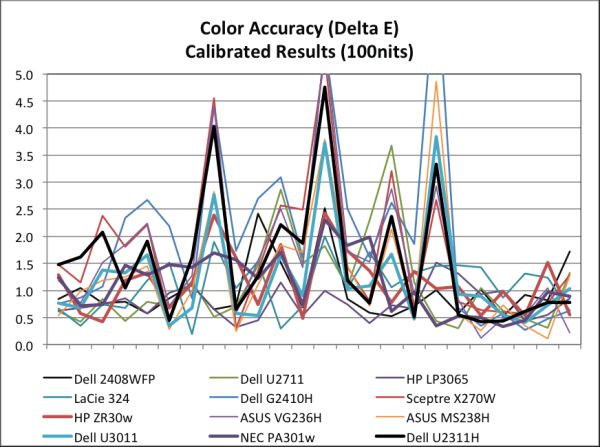








65 Comments
View All Comments
pjfan75 - Tuesday, September 27, 2011 - link
Can you post the calibration settings you used?Thanks!
cheinonen - Tuesday, September 27, 2011 - link
I will grab the settings I used when I hook it up for the input lag test, but since the majority of the work is done with the LUTs in your graphics chip, and not in the display itself, it really won't get you that much of an improvement over the stock settings unfortunately.Zoomer - Tuesday, September 27, 2011 - link
How about a review of HP's line, the ZR24w, etc, or maybe even a comparison?Makaveli - Tuesday, September 27, 2011 - link
I own a ZR24w and I would love to see this. From what I have researched the HP screen uses a real 8 bit panel and would love to see this compared to the 6bit+AFC in this. I'm sure if the Dell 24 inch version is also a non 8 bit panel?TegiriNenashi - Tuesday, September 27, 2011 - link
EOMthe_engineer - Tuesday, September 27, 2011 - link
I Love these monitor reviews. Thanks for working hard on this! I would REALLY love to see a comparison of the current monitor technologies (H-IPS; E-IPS; Samsung's newest tech; TN Panels; Discussion of diffrent styles of LED backlights etc....) and which monitor lines we can find each tech in. This is a very complex issue and actually very pressing for those of us amateur turning-pro photographers and graphic designers on a budget. I've even seen some 40"+ LED backlit Televisions that claim to use IPS technology that i've considered for a display mostly for the price per inch ratio seems so good. Any thoughts on why that might be a bad idea if they are IPS panels?fausto412 - Wednesday, September 28, 2011 - link
yes, i would like to see comparison of technologies...TwinIon - Tuesday, September 27, 2011 - link
I own three of these. Great monitors for the price, but wait for a Dell sale. I got mine for closer to $250 each.Displayport was a real benefit for me since I wanted to use the screens for eyefinity, which requires DP for at least one monitor. The ability to adjust the screens has also proved very important for eyefinity.
xi1inx - Tuesday, September 27, 2011 - link
I remember in the last 12 mouth, another Dell IPS screen was reviewed here. I recall this monitor have also the same price and have a Genesys board inside to drive the lcd. It's perhaps the same monitor with the dvi port instead, So, I saw many reader comments say this ips lcd is bad. I prefer at this point to pursage a nice and bright used Apple Cinema Display HD 23" for the same price. I very happy with this screen and I'm not regrating to don't have buy the Dell one.I think the Apple Cinema Display HD 23" could be a good comparison monitor to compare with new incomers, if you could found one like new. It perhaps an old monitor but it certainly clash with the Dell offers.
Despoiler - Tuesday, September 27, 2011 - link
Check out the NEC EA231WMi. It has since been discontinued for a newer model with a LED backlight, but I got it just south of $300. It suffers none of the issues Dell's E-IPS panels do. It can be calibrated to be quite accurate. In fact you can download a calibration file from TFT Central from their review. You can get .inf files for 75hz and 83hz over display port. There is no input lag or ghosting that I can detect and I play a lot of video games. The stand on it is epicly good. Simply put there are a lot better and cheaper E-IPS panels than what Dell offers. NEC is worth the look.